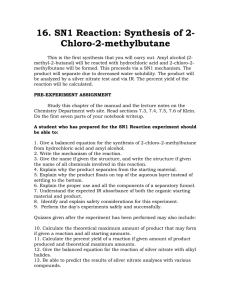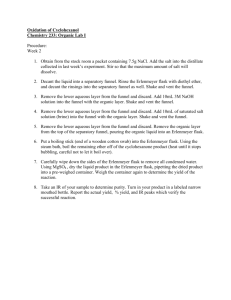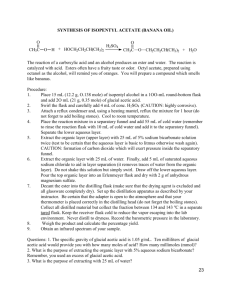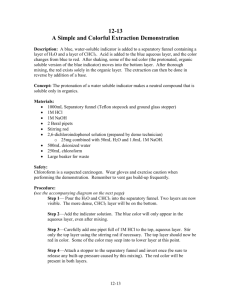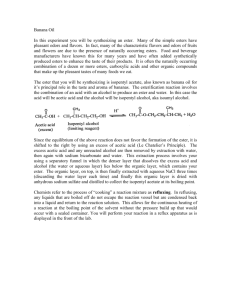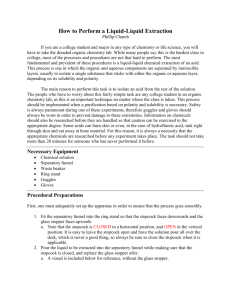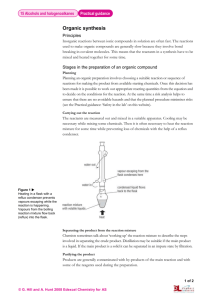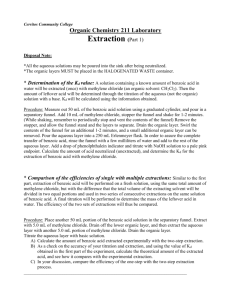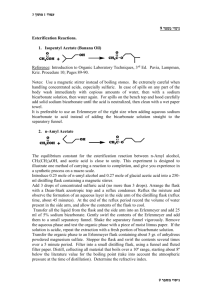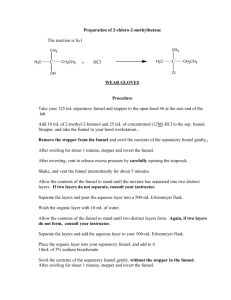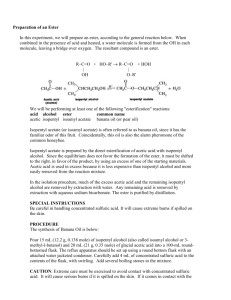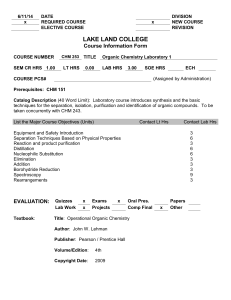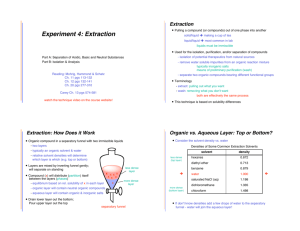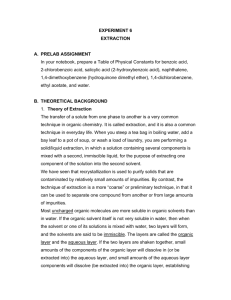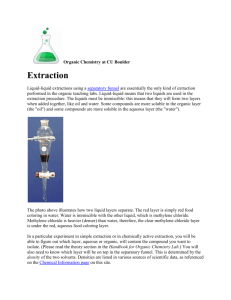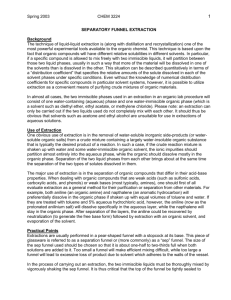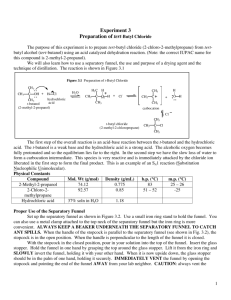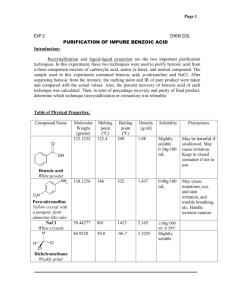Project 2 - Chemistry Courses: About
advertisement
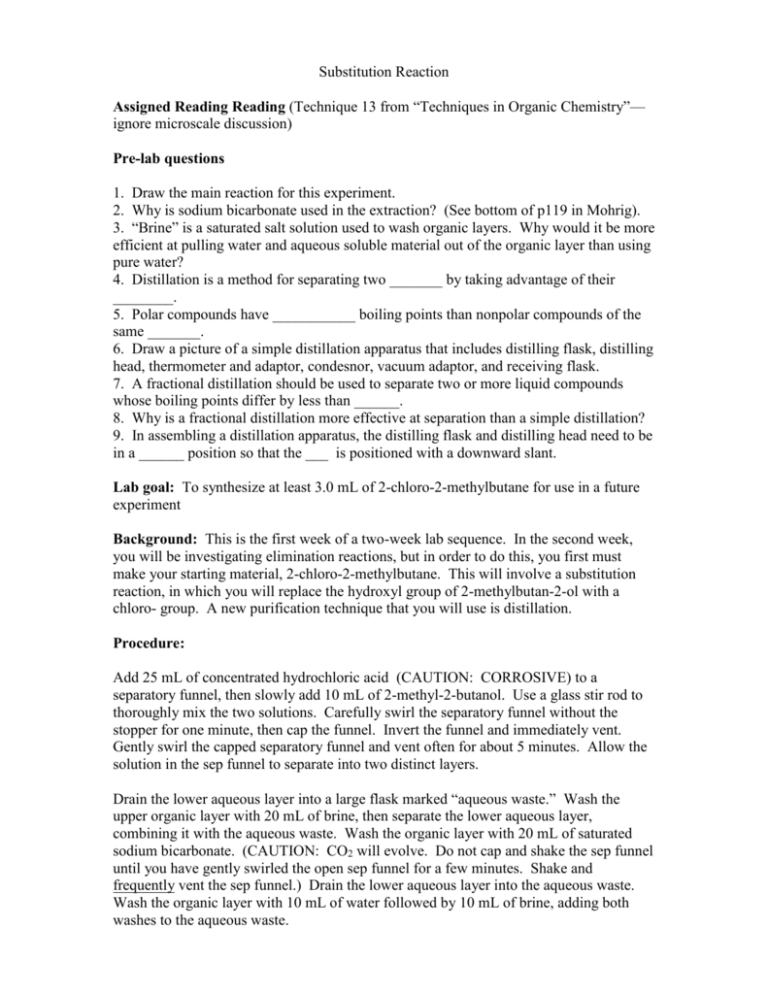
Substitution Reaction Assigned Reading Reading (Technique 13 from “Techniques in Organic Chemistry”— ignore microscale discussion) Pre-lab questions 1. Draw the main reaction for this experiment. 2. Why is sodium bicarbonate used in the extraction? (See bottom of p119 in Mohrig). 3. “Brine” is a saturated salt solution used to wash organic layers. Why would it be more efficient at pulling water and aqueous soluble material out of the organic layer than using pure water? 4. Distillation is a method for separating two _______ by taking advantage of their ________. 5. Polar compounds have ___________ boiling points than nonpolar compounds of the same _______. 6. Draw a picture of a simple distillation apparatus that includes distilling flask, distilling head, thermometer and adaptor, condesnor, vacuum adaptor, and receiving flask. 7. A fractional distillation should be used to separate two or more liquid compounds whose boiling points differ by less than ______. 8. Why is a fractional distillation more effective at separation than a simple distillation? 9. In assembling a distillation apparatus, the distilling flask and distilling head need to be in a ______ position so that the ___ is positioned with a downward slant. Lab goal: To synthesize at least 3.0 mL of 2-chloro-2-methylbutane for use in a future experiment Background: This is the first week of a two-week lab sequence. In the second week, you will be investigating elimination reactions, but in order to do this, you first must make your starting material, 2-chloro-2-methylbutane. This will involve a substitution reaction, in which you will replace the hydroxyl group of 2-methylbutan-2-ol with a chloro- group. A new purification technique that you will use is distillation. Procedure: Add 25 mL of concentrated hydrochloric acid (CAUTION: CORROSIVE) to a separatory funnel, then slowly add 10 mL of 2-methyl-2-butanol. Use a glass stir rod to thoroughly mix the two solutions. Carefully swirl the separatory funnel without the stopper for one minute, then cap the funnel. Invert the funnel and immediately vent. Gently swirl the capped separatory funnel and vent often for about 5 minutes. Allow the solution in the sep funnel to separate into two distinct layers. Drain the lower aqueous layer into a large flask marked “aqueous waste.” Wash the upper organic layer with 20 mL of brine, then separate the lower aqueous layer, combining it with the aqueous waste. Wash the organic layer with 20 mL of saturated sodium bicarbonate. (CAUTION: CO2 will evolve. Do not cap and shake the sep funnel until you have gently swirled the open sep funnel for a few minutes. Shake and frequently vent the sep funnel.) Drain the lower aqueous layer into the aqueous waste. Wash the organic layer with 10 mL of water followed by 10 mL of brine, adding both washes to the aqueous waste. Pour the organic phase into a 25 mL Erlenmeyer flask, and dry the liquid with anhydrous calcium chloride for 10 minutes. Decant the liquid into a 25 mL roundbottom flask. Obtain microscale glassware kit from the stockroom. Assemble a simple distillation apparatus, and collect the distillate that comes over between 80-86 oC. Put the product in a tightly capped, labeled container for use in the next lab period. (It would be a good idea to tare this container first so that you can determine how much product you made without having to do another transfer.) Waste: Dispose of aqueous waste, leftover organic distillate, and calcium chloride in appropriate containers. Notebook Guideline Above the procedure, include a Main Reaction and table of data, writing in the THEORETICAL mass and volume of product formed: Molecular Weight Grams Moles Density or molarity Volume Limiting, excess, or catalytic? _______________ 12.0 Molar _______________ --------------------- Observations and Results: For a distillation, you should definitely include the boiling point range of what distilled. What other data do you generally collect? What other data will be needed to answer the discussion questions? Discussion Comments: Draw a reasonable mechanism for the formation of 2-chloro-2-methylbutane. Why did two layers form in your separatory funnel after the initial reaction when there was only one to start with? After you drained the lower aqueous layer from the initial reaction, you washed the organic layer with sodium bicarbonate. Why did you do this? What caution did you have to take and why? What was the purpose of CaCl2? How can your distillation data be used to determine the purity of your product? Based on your data, was your product pure? What was the percent yield of your final product? Show your calculation. According to SigmaAldrich, how much does 250mL of 2-methyl-2-butanol (product number 152463) cost? How much does 100 grams of 2-chloro-2-methylbutane (product number 277029) cost? Use these data to explain the financial benefit of synthesis. Conclusion: Explain whether or not you accomplished your experimental goal. Reference(s): Accepted boiling point of 2-chloro-2-methylbutane, reference for prices

